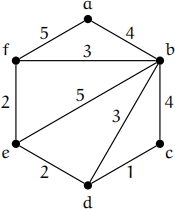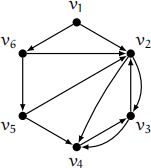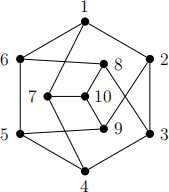MTH6105: Algorithmic Graph Theory Main Examination period 2021
Hello, dear friend, you can consult us at any time if you have any questions, add WeChat: daixieit
Main Examination period 2021 – May/June – Semester B
Online Alternative Assessments
MTH6105: Algorithmic Graph Theory
Question 1 [22 marks]. Consider the following network (G, w), in which each vertex is labeled with its name and each edge e e E(G) with its weight w(e).

(a) Use Prim’s algorithm starting from vertex a to find a minimum spanning tree of (G, w). Show your working and give the minimum spanning tree and its weight. [10]
(b) Find another minimum spanning tree of (G, w). Show your working and give the minimum spanning tree and its weight. [4]
(c) Does there exist a minimum spanning tree of (G, w) that does not contain the edge de? Justify your answer. [4]
(d) Does there exist a minimum spanning tree of (G, w) that contains both of the edges bd and bf? Justify your answer. [4]
Question 2 [26 marks]. Consider a tree T in which the degree of each vertex is either 1 or 3. Let n = 1V(T )1.
(a) Show that n is even. [2]
(b) Show that T has ![]() + 1 leaves. [6]
+ 1 leaves. [6]
(c) Determine the number of distinct simple graphs G such that T is a spanning tree of G. Explain your reasoning. [6]
Call a graph G a tree-set if every connected component of G is a tree.
(d) For each of the following graphs, determine if the graph is a tree-set. Justify your answer. [6]
(i) The graph G1 with V(G1 ) = {v1 , v2 , v3 , v4 , v5 , v6) and E(G1 ) = 0
(ii) The graph G2 with V(G2 ) = V(G1 ) and E(G2 ) = {v1v2 , v2v4 , v2v6 , v4v6)
(iii) The graph G3 with V(G3 ) = V(G1 ) and E(G3 ) = {v1v5 , v2v6 , v3v4 , v5v6) Now consider an arbitrary graph G.
(e) Give a polynomial-time algorithm to determine whether G is a tree-set. Show that the algorithm is indeed a polynomial-time algorithm. [6]
Question 3 [24 marks]. Consider the following digraph D, in which each vertex is labeled with its name.

![]() (a) Determine the strongly connected components of D. Show your working. Now consider the directed network (D, w), where w : A(D) → R with
(a) Determine the strongly connected components of D. Show your working. Now consider the directed network (D, w), where w : A(D) → R with


![]() w(v2v3 ) = 1,
w(v2v3 ) = 1,
w(v4v3 ) = 1,
w(v6v5 ) = 1.
presence of negative weights. Illustrate this fact by giving vertices u, v e V(D)
such that Dijkstra’s algorithm fails to find a shortest directed u−v-path in
(D, w). Explain your reasoning. [6]
(c) Use the Bellman-Ford algorithm to find a shortest directed v1 −v3-path in (D, w). Show your working. [12]
Question 4 [28 marks].
(a) For each of the following graphs, state if the graph is bipartite or not. Justify
![]() your answer.
your answer.
(i)

(ii)

(iii)

Now consider the bipartite graph G with
V(G) = {u1 , u2 , u3 , u4 , u5 , u6 , v1 , v2 , v3 , v4 , v5 , v6)
E(G) = {u1v2 , u1v4 , u2v1 , u2v2 , u2v3 , u2v4 , u2v5 , u2v6 , u3v2 , u3v4 , u4v2 , u4v3 , u4v4 , u5v2 , u5v4 , u6v1 , u6v2 , u6v4 , u6v5 , u6v6).
(c) For each of the following sets, state if the set is a matching of G or not. Justify
your answer. [ ]6
(i) M1 = {u1v2 , u2v1 , u5v2 , u6v4)
(ii) M2 = {u1v2 , u2v1 , u3v3 , u4v4)
(iii) M3 = {u1v4 , u2v2 , u4v3 , u6v5)
(d) Find a maximum matching of G. Show your working. [10]
(e) Show that the matching you have found is indeed a maximum matching. [4]
2023-05-28